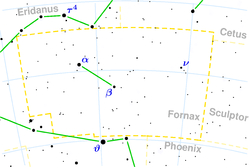Alpha Fornacis
 Location of α Fornacis (upper left). | |
| Observation data Epoch J2000 Equinox J2000 | |
|---|---|
| Constellation | Fornax |
| Right ascension | 3h 12m 04.5277s[1] |
| Declination | –28° 59′ 15.425″[1] |
| Apparent magnitude (V) | 3.85[2] |
| Characteristics | |
| Spectral type | F8IV[3] |
| U−B color index | +0.082[4] |
| B−V color index | +0.581[4] |
| Astrometry | |
| Radial velocity (Rv) | –20.5[5] km/s |
| Proper motion (μ) | RA: 371.49[1] mas/yr Dec.: 612.28[1] mas/yr |
| Parallax (π) | 70.24 ± 0.45[1] mas |
| Distance | 46.4 ± 0.3 ly (14.24 ± 0.09 pc) |
| Details | |
| Mass | 1.33 ± 0.01[6] M☉ |
| Radius | 2.04 ± 0.06[7] R☉ |
| Luminosity | 4.87 ± 0.16[7] L☉ |
| Surface gravity (log g) | 4.27[6] cgs |
| Temperature | 6,240[6] K |
| Metallicity [Fe/H] | –0.20[6] dex |
| Rotational velocity (v sin i) | 3.9[7] km/s |
| Age | 2.9[8] Gyr |
| Other designations | |
| Database references | |
| SIMBAD | data |
Alpha Fornacis (α Fornacis, α For) is the brightest star in the constellation Fornax. It is the only star brighter than magnitude 4.0 in the constellation. It has the proper names Dalim (in Piazzi's Palermo Catalogue)[9][10][11] and Fornacis (in Burritt's Atlas).[12] This star was formally identical with 12 Eridani.
The stellar classification of Alpha Fornacis is F8IV, where the luminosity class IV indicates this is a subgiant star that has just evolved off the main sequence.[13] It has 33% more mass than the Sun and is an estimated 2.9 billion years old.[6][8] Alpha Fornacis is a binary star[14] and has a high proper motion.[2] This system displays an excess of infrared emission, which may indicate the presence of circumstellar material such as a debris disk.[15]
The secondary has been identified as a blue straggler, and has either accumulated material from, or merged with, a third star in the past. It is a strong source of X-rays and is 78% as massive as the Sun.[16]
The space velocity components of this star are (U, V, W) = (–35, +20, +30) km/s.[17] Approximately 350,000 years ago, Alpha Fornacis experienced a close encounter with the A-type main sequence star Nu Horologii. The two came within an estimated 0.265 ly (0.081 pc) of each other, and both stars have debris disks.[18]
References
- 1 2 3 4 5 Perryman, M. A. C.; et al. (April 1997). "The HIPPARCOS Catalogue". Astronomy & Astrophysics. 323: L49–L52. Bibcode:1997A&A...323L..49P.
- 1 2 3 "LHS 1515 -- High proper-motion Star". SIMBAD. Centre de Données astronomiques de Strasbourg. Retrieved 2010-05-10.
- ↑ Favata, F.; Micela, G.; Sciortino, S. (July 1997). "The [Fe/H] distribution of a volume limited sample of solar-type stars and its implications for galactic chemical evolution.". Astronomy and Astrophysics. 323: 809–818. Bibcode:1997A&A...323..809F.
- 1 2 Rakos, K. D.; et al. (February 1982). "Photometric and astrometric observations of close visual binaries". Astronomy and Astrophysics Supplement Series. 47: 221–235. Bibcode:1982A&AS...47..221R.
- ↑ Evans, D. S. (June 20–24, 1966). "The Revision of the General Catalogue of Radial Velocities". In Batten, Alan Henry; Heard, John Frederick. Determination of Radial Velocities and their Applications, Proceedings from IAU Symposium no. 30. University of Toronto: International Astronomical Union. Bibcode:1967IAUS...30...57E. Retrieved 2009-09-10.
- 1 2 3 4 5 Santos, N. C.; Israelian, G.; Mayor, M. (July 2001). "The metal-rich nature of stars with planets". Astronomy and Astrophysics. 373 (3): 1019–1031. arXiv:astro-ph/0105216
 . Bibcode:2001A&A...373.1019S. doi:10.1051/0004-6361:20010648.
. Bibcode:2001A&A...373.1019S. doi:10.1051/0004-6361:20010648. - 1 2 3 Bruntt, H.; et al. (July 2010), "Accurate fundamental parameters for 23 bright solar-type stars", Monthly Notices of the Royal Astronomical Society, 405 (3): 1907–1923, arXiv:1002.4268
 , Bibcode:2010MNRAS.405.1907B, doi:10.1111/j.1365-2966.2010.16575.x
, Bibcode:2010MNRAS.405.1907B, doi:10.1111/j.1365-2966.2010.16575.x - 1 2 Nordström, B.; Mayor, M.; Andersen, J.; Holmberg, J.; Pont, F.; Jørgensen, B. R.; Olsen, E. H.; Udry, S.; Mowlavi, N. (May 2004). "The Geneva-Copenhagen survey of the Solar neighbourhood. Ages, metallicities, and kinematic properties of ˜14 000 F and G dwarfs". Astronomy and Astrophysics. 418 (3): 989–1019. arXiv:astro-ph/0405198
 . Bibcode:2004A&A...418..989N. doi:10.1051/0004-6361:20035959. See VizierR catalogue V/130.
. Bibcode:2004A&A...418..989N. doi:10.1051/0004-6361:20035959. See VizierR catalogue V/130. - ↑ Piazzi, G, ed. (1814). Praecipuarum Stellarum Inerrantium Positiones Mediae Ineunte Saeculo XIX: ex Observationibus Habitis in Specula Panormitana ab anno 1792 ad annum 1813. Palermo. p. 21.
- ↑ Kunitzsch, P. (1959). Arabische Sternnamen in Europa. Wiesbaden: Otto Harrassowitz. p. 155.
- ↑ Laffitte, R. (2005). Héritages arabes: Des noms arabes pour les étoiles (2éme revue et corrigée ed.). Paris: Librairie Orientaliste Paul Geunthner / Les Cahiers de l'Orient. p. 229.
- ↑ Burritt, E. H. (1835). Atlas, Designed to Illustrate the Geography of the Heavens (new ed.). New York: F. J. Huntington. plate III.
- ↑ Lopez, Bruno; Schneider, Jean; Danchi, William C. (July 2005). "Can Life Develop in the Expanded Habitable Zones around Red Giant Stars?". The Astrophysical Journal. 627 (2): 974–985. arXiv:astro-ph/0503520
 . Bibcode:2005ApJ...627..974L. doi:10.1086/430416.
. Bibcode:2005ApJ...627..974L. doi:10.1086/430416. - ↑ Söderhjelm, Staffan (January 1999). "Visual binary orbits and masses POST HIPPARCOS". Astronomy and Astrophysics. 341: 121–140. Bibcode:1999A&A...341..121S.
- ↑ Oudmaijer, Rene D.; et al. (December 1992). "SAO stars with infrared excess in the IRAS Point Source Catalog". Astronomy and Astrophysics Supplement Series. 96 (3): 625–643. Bibcode:1992A&AS...96..625O.
- ↑ Fuhrmann, K.; Chini, R. (August 2015), "Multiplicity among F-type Stars. II", The Astrophysical Journal, 809 (1): 19, Bibcode:2015ApJ...809..107F, doi:10.1088/0004-637X/809/1/107, 107.
- ↑ Gliese, W. (1969). "Catalogue of Nearby Stars". Veröffentlichungen des Astronomischen Rechen-Instituts Heidelberg. Bibcode:1969VeARI..22....1G.
- ↑ Deltorn, J.-M.; Kalas, P. (2001). "Search for Nemesis Encounters with Vega, ε Eridani, and Fomalhaut". In Ray Jayawardhana; Thomas Greene. Young Stars Near Earth: Progress and Prospects. ASP Conference Series. 244. San Francisco: Astronomical Society of the Pacific. p. 227. Bibcode:2001ASPC..244..227D. ISBN 1-58381-082-X.